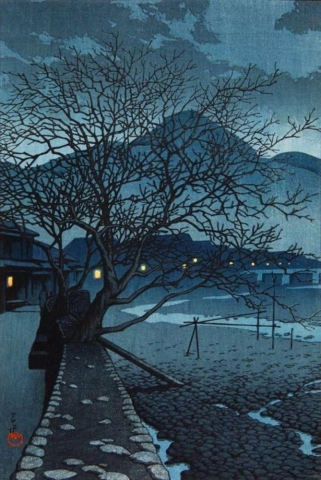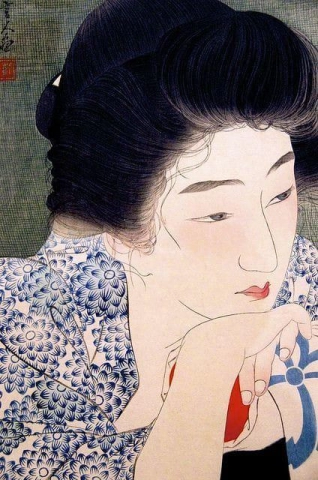Hand-painted painting reproductions - Movements - Shin-Hanga
Imagine owning a museum-worthy piece of art, created by the greatest artists in history and reproduced by passionate and experienced painters. At POD, we offer you the opportunity to make that dream a reality. We reproduce the works of art of your favorite painters from the Shin-Hanga art movement in the smallest details, so that you can enjoy them in your own home.
Our reproductions are made by experienced artists who use the best materials and techniques. We are committed to providing you with works of art of the highest quality, which will bring joy and inspiration to your family for generations to come.
The Shin-Hanga movement, or "New Prints," emerged in Japan in the early 20th century as a significant revitalization of traditional Japanese woodblock printing. This movement, which began in the 1910s and continued into the 1960s, represents a fascinating chapter in the evolution of Japanese art, blending the revered techniques of Ukiyo-e with modern aesthetics and innovations. The story of Shin-Hanga is one of artistic revival and transformation, reflecting Japan's dynamic social and cultural changes during this period.
At the heart of the Shin-Hanga movement was a desire to breathe new life into the ancient art form of woodblock printing. Ukiyo-e, the "pictures of the floating world," was a popular genre during the Edo period (1603-1868) that depicted scenes of landscapes, kabuki actors, beautiful women, and everyday life. By the late 19th century, however, Ukiyo-e had waned in popularity due to the rise of Western art styles and techniques. The Shin-Hanga movement sought to reintroduce these traditional methods while incorporating contemporary elements, thus bridging the past with the present.
Shin-Hanga artists were deeply influenced by the Western art movements of the time, particularly Impressionism and Post-Impressionism. These influences are evident in the way Shin-Hanga prints emphasize light, atmosphere, and a more realistic depiction of nature and daily life. Artists within the movement embraced new techniques and materials, experimenting with the use of color and texture to create prints that were more vivid and detailed than their predecessors.
One of the key figures in the Shin-Hanga movement was the talented artist Hasui Kawase, whose works exemplify the movement's core principles. Kawase and his contemporaries sought to capture the serene beauty of the Japanese landscape with a modern touch. His prints often feature tranquil scenes of nature, including tranquil lakes, misty mountains, and picturesque rural settings. Kawase’s attention to detail and masterful use of color brought a fresh perspective to traditional subjects, making his work highly sought after both in Japan and abroad.
The Shin-Hanga movement was not just about individual artists; it was also a collective effort to revive and sustain traditional woodblock printing. Print publishers and workshops played a crucial role in this revival, supporting artists and facilitating the production of high-quality prints. The movement saw the collaboration of skilled craftsmen, including carvers and printers, who worked together to produce exquisite works of art. This collaboration ensured that the Shin-Hanga prints maintained the technical excellence of Ukiyo-e while introducing new artistic sensibilities.
A significant aspect of Shin-Hanga is its focus on capturing the essence of Japanese culture and landscape in a way that resonated with contemporary audiences. The movement’s prints often depict iconic elements of Japanese life, such as seasonal changes, traditional festivals, and scenic views of famous landmarks. By highlighting these aspects with a modern twist, Shin-Hanga artists provided a fresh lens through which to appreciate Japan's cultural heritage.
The Shin-Hanga movement also played a role in international art circles, helping to renew interest in Japanese printmaking worldwide. Exhibitions of Shin-Hanga prints attracted attention from art collectors, museums, and critics, leading to a broader appreciation of Japanese art in the global arena. This international exposure contributed to the movement's lasting legacy and its influence on subsequent art trends.
As the 20th century progressed, the popularity of Shin-Hanga eventually waned, giving way to other art movements and styles. However, the impact of Shin-Hanga on the art world remains significant. The movement's revival of traditional techniques, coupled with its innovative approach, left a lasting imprint on Japanese art and beyond. Today, Shin-Hanga prints are celebrated for their beauty, craftsmanship, and historical significance, continuing to captivate audiences and collectors around the world.
The story of Shin-Hanga is one of artistic renewal and cultural pride, a testament to the enduring appeal of traditional art forms when reimagined through a modern lens. It represents a unique chapter in the history of Japanese art, where old and new converged to create a vibrant and influential movement. Through its exquisite prints and innovative spirit, Shin-Hanga remains a cherished part of Japan’s artistic heritage, reflecting both its rich history and its dynamic evolution.








